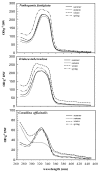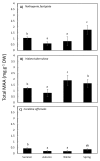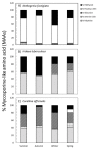Seasonal Variation of Mycosporine-Like Amino Acids in Three Subantarctic Red Seaweeds
- PMID: 31991623
- PMCID: PMC7074333
- DOI: 10.3390/md18020075
Seasonal Variation of Mycosporine-Like Amino Acids in Three Subantarctic Red Seaweeds
Abstract
UV-absorbing compounds, such as mycosporine-like amino acids (MAAs), are a group of secondary metabolites present in many marine species, including red seaweeds. In these organisms, the content and proportion of the composition of MAAs vary, depending on the species and several environmental factors. Its high cosmetic interest calls for research on the content and composition of MAAs, as well as the dynamics of MAAs accumulation in seaweeds from different latitudes. Therefore, this study aimed to survey the content of UV-absorbing MAAs in three Subantarctic red seaweeds during a seasonal cycle. Using spectrophotometric and HPLC techniques, the content and composition of MAAs of intertidal Iridaea tuberculosa, Nothogenia fastigiate, and Corallina officinalis were assessed. Some samples were also analyzed using high-resolution mass spectrometry coupled with HPLC-ESI-MS in order to identify more precisely the MAA composition. I. tuberculosa exhibited the highest MAA values (above 1 mg g-1 of dried mass weight), while C. officinalis showed values not exceeding 0.4 mg g-1. Porphyra-334 was the main component in N. fastigiata, whereas I. tuberculosa and C. officinalis exhibited a high content of palythine. Both content and composition of MAAs varied seasonally, with high concentration recorded in different seasons, depending on the species, i.e., winter (I. tuberculosa), spring (N. fastigiata), and summer (C. officinalis). HPLC-ESI-MS allowed us to identify seven different MAAs. Two were recorded for the first time in seaweeds from Subantarctic areas (mycosporine-glutamic acid and palythine-serine), and we also recorded an eighth UV-absorbing compound which remains unidentified.
Keywords: Corallina; Iridaea; Mycosporine-like amino acids; Nothogenia; red algae.
Conflict of interest statement
The authors declare no conflict of interest.
Figures




References
-
- Lucas R.M.K., Yazar S., Young A.R., Norval M., de Grujil F.R., Takizawa Y., Rhodes L.E., Sinclair C.A., Neale R.E. Human health in relation to exposure to solar ultraviolet radiation under changing stratospheric ozone and climate. Photochem. Photobiol. Sci. 2019;18:641–680. doi: 10.1039/C8PP90060D. - DOI - PubMed
-
- Williamson C.E., Neale P.J., Hylander S., Rose K.C., Figueroa F.L., Robinson S., Häder D.-P., Wängberg S.-A., Worrest R.C. The interactive effects of staospheric ozone depletion, UV radiation, and climate change on aquatic ecosystems. Photochem. Photobiol. Sci. 2019;18:717–746. doi: 10.1039/C8PP90062K. - DOI - PubMed
-
- Wilson S.R., Madronich S., Longstreth J.D., Solomon K.R. Interactive effects of changing stratospheric ozone and climate on tropospheric composition and air quality, and the consequences for human and ecosystem health. Photochem. Photobiol. Sci. 2019;18:775–803. doi: 10.1039/C8PP90064G. - DOI - PubMed
-
- Korbee N., Figueroa F., Aguilera A. Acumulación de aminoácidos tipo micosporina (MAAs): Biosíntesis, fotocontrol y funciones ecofisiológicas. Rev. Chil. Hist. Nat. 2006;79:119–132. doi: 10.4067/S0716-078X2006000100010. - DOI
MeSH terms
Substances
LinkOut - more resources
Full Text Sources
Medical

